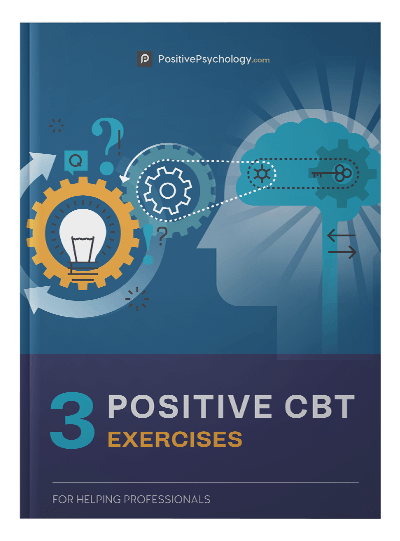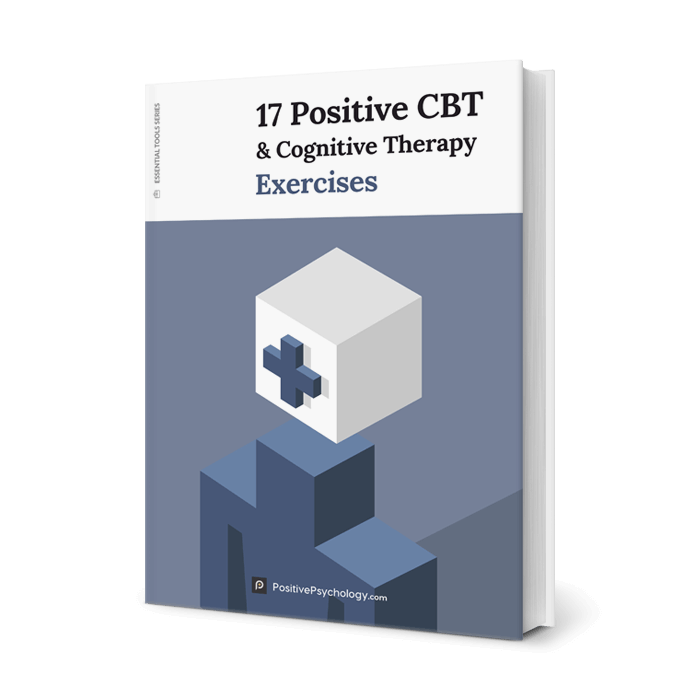Self-Disclosure in Therapy and Counseling: 7 Examples
 Sharing personal information with a client during treatment can be helpful or harmful.
Sharing personal information with a client during treatment can be helpful or harmful.
Self-disclosure is a choice, and its outcome is moderated by the mental health professional’s motivation to disclose (Metcalf, 2011).
“Deliberate self-disclosure is the psychotherapist’s intentional self-disclosure of personal information to the client” in therapy, including feelings, personal experiences, and reactions (Barnett, 2011, p. 315).
While there is considerable disagreement about its use, many therapists would agree that self-disclosure is a valuable technique with many benefits when performed correctly.
This article explores the practice of self-disclosure in counseling and therapy, why it can be helpful, and the resulting risks.
Before you continue, we thought you might like to download our three Positive CBT Exercises for free. These science-based exercises will provide you with detailed insight into positive Cognitive-Behavioral Therapy and give you the tools to apply it in your therapy or coaching.
This Article Contains:
- What Is Self-Disclosure in Communication?
- 3 Psychology Theories About Self-Disclosure
- Using Self-Disclosure in Therapy and Counseling
- 7 Examples of Self-Disclosure in Therapy
- Why Is Self-Disclosure Important? 6 Benefits
- Is It Appropriate to Self-Disclose? 5 Possible Risks
- 9 Self-Disclosure Skills and Guidelines
- 4 Questions to Ask Clients in Your Sessions
- Resources From PositivePsychology.com
- A Take-Home Message
- References
What Is Self-Disclosure in Communication?
Psychologist, professor, and author Sidney Jourard first coined the term “self-disclosure” in 1958, and it has remained controversial ever since (Henretty, Currier, Berman, & Levitt, 2014).
Self-disclosure typically refers to “utterances that reveal personal information about the therapist” (Hill & Knox, 2002, p. 1) to their client; it excludes details related to the treatment, the therapist’s credentials, office policies, and emergency contact details (Barnett, 2011).
It can fall into two categories (Alfi-Yogev et al., 2021):
- Immediate disclosure, when a therapist reveals their present feelings, thoughts, and opinions toward their clients, the treatment, or the therapeutic relationship (e.g. “I’m impressed by the progress you’ve made.”)
- Non-immediate disclosure, which refers to a therapist divulging information on their life outside of treatment. It may include personal beliefs, values, life events and past experiences (e.g. “I used to struggle a lot with Imposter Syndrome and I found CBT very helpful.”)
Despite concerns raised, research suggests “in reality that therapists generally do disclose” personal information about themselves and their beliefs, and that it happens more often than many would assume (Danzer, 2019, p. 3).
While many “professional counselors and therapists disagree on the effectiveness of self-disclosure,” they remain in agreement that it should be discouraged if it hurts or harms the client (Metcalf, 2011, p. 28).
When deciding to use self-disclosure deliberately, it is essential to explore why you think it might be helpful to share a personal story or details, asking yourself (Metcalf, 2011):
- Will it provide new information to the client?
- Will it shift my relationship with them, perhaps making me more available?
- Could it help create a positive and healthy sense of shared vulnerability?
Self-disclosure can help therapists align with their clients, humanize them, normalize struggles, and introduce new perspectives (Metcalf, 2011).
Self-disclosure can have several other positive points, including (Henretty et al., 2014):
- Revealing similarity between the client and counselor
- Offering a more favorable perception of the counselor as a professional
- Increasing clients’ willingness to return and continue treatment
However, findings also suggest several factors that can affect treatment outcomes. For example, the timing of the self-disclosure (before or after the client’s) and whether the therapist favors disclosure can impact its degree of success (Henretty et al., 2014).
3 Psychology Theories About Self-Disclosure

Behavioral, Cognitive, and Cognitive-Behavioral Therapies have all recognized the value of self-disclosure in treatment, potentially improving modeling, reinforcing, normalizing, improving therapeutic bonds, and increasing the chance of positive outcomes (Metcalf, 2011).
But why should revealing personal information, thoughts, and beliefs have such profound effects?
Masaviru (2016) discussed three theories that may help explain self-disclosure and how it encourages the development of human relationships.
Social exchange theory (SET)
Introduced in 1956 by sociologist George Homans, SET suggests that “rewards and costs drive relationship decisions.” We subtract costs from rewards to calculate the overall worth of a relationship (Masaviru, 2016, p. 44). Crucially, a relationship’s worth predicts its outcome.
In this model, self-disclosure is part of a mutually beneficial exchange where the therapist supplies the client’s wants at a cost to themselves that is lower than the resources provided by the other party. Therefore, self-disclosure promotes positive behavior and increases the chance of it being repeated (Masaviru, 2016).
Communication privacy management (CPM) theory
CPM theory suggests that when we share information with another person, we are reshaping and rethinking privacy boundaries.
By disclosing private details about ourselves as therapists, we draw the client into a collective privacy boundary. And in response to this process of self-disclosure, the shared boundary never shrinks back to being a personal one again (Masaviru, 2016).
Social penetration theory (SPT)
Developed in 1973 (and revisited in 1987) by Irwin Altman and Dallas Taylor, the SPT suggests we have multiple layers of personality. As we build intimacy, each partner assesses the rewards versus the costs of the relationship using the information they have already gathered (Masaviru, 2016).
In turn, self-disclosure increases closeness, strengthens the therapeutic alliance, and predicts increased rewards.
Both SET and SPT suggest that self-disclosure improves the therapist–client relationship through increasing rewards and, like CPM, moves from a superficial layer to intimacy.
Using Self-Disclosure in Therapy and Counseling
“The psychotherapist’s theoretical orientation will directly impact each psychotherapist’s view and approach to boundaries” (Barnett, 2011, p. 319). Psychotherapists from various backgrounds are beginning to recognize self-disclosure as a vital aspect of the therapeutic process and alliance.
If used appropriately, self-disclosure has many benefits in therapy and counseling. However, it must consider the psychotherapist’s intent and its impact on the client (Barnett, 2011).
Contemporary clinical perspectives
According to Danzer (2019, p. 18), “therapist disclosures driven by empathy and caring may have positive impacts on the client’s perception of the therapist,” decreasing the client’s sense of isolation and disconnectedness.
However, the first decision for the therapist or counselor is whether or not to disclose. Often short on time, as conversations can move quickly during therapy, they must decide how much, if anything, to disclose and to what depth. Therefore, it may be advisable for the therapist to arrive at a personal self-disclosure policy and possibly even ask the client’s permission in advance (Danzer, 2019).
But the questions regarding self-disclosure do not end there. Timing and frequency are also crucial. Finding the right point during a session requires skill and experience, especially when a client requires multiple interventions. Early disclosures should help build rapport; however, research suggests they can also be valuable during termination.
Ultimately, the therapist’s approach to self-disclosure will most likely remain flexible, based on decision-making in the moment. While prior preparation is advised, no set of rules can account for every situation (Danzer, 2019).
How does self-disclosure work in social work?
Many social workers are wary of disclosing personal information as it can blur boundaries and risk damaging trust. Also, supplying personal details can unwittingly aid someone in conducting online searches to gather information about the social worker or therapist (Farrah, 2013).
Given the nature of the working relationship between social worker and client, self-disclosure should serve the specific needs of the client and respect the boundaries of the client–social worker connection (Farrah, 2013).
7 Examples of Self-Disclosure in Therapy

Examples include (Barnett, 2011):
- In response to questions from the client, such as, “Do you have children?” or “Are you married?”
- To assist or encourage the client by offering previous successes or advice, including, “I have found the following strategies helpful with my other clients.”
- Personal reactions, such as shock, disgust, or humor, can all reveal personal beliefs and feelings.
- Having family photographs or pictures of the therapist performing a hobby or winning an award can be impactful to the client.
- Outside of the session, self-disclosure can take the form of an online presence, posting about yourself, or participating in discourse on blogs.
- Disclosure of family leave or vacation can be necessary, but consideration is required regarding the degree of sharing. Too much can be inappropriate, but too little may leave the client concerned regarding the future availability of their treatment.
- Sometimes, self-disclosure is unavoidable. Our attire, such as head coverings and wedding rings, can express our identity and even result in specific biases from the client. Physical disabilities may be visible and lead to conversation or questions regarding past events.
Self-disclosure can also be accidental and purely a result of coincidence; a chance meeting at a community event or activity may suggest a religious or political belief.
Why Is Self-Disclosure Important? 6 Benefits
Many psychotherapists and researchers recognize self-disclosure as crucial for developing the therapeutic alliance (Barnett, 2011).
Audet and Everall (2010) explored clients’ real experiences of therapist self-disclosure and identified several benefits, grouped under the following three themes:
- Forming an early connection with the therapist
Early self-disclosure, typically in the first three sessions, “contributed to an atmosphere of comfort and general ease” and “balanced the asymmetry imposed by the one-way exchange,” (Audet & Everall, 2010, p. 333) leading to:- A brief reprieve for the client from being in the spotlight, providing a sense of relief
- A more balanced and human relationship
- Maintaining therapist presence
Disclosure can resonate with the client’s personal experiences, feelings, and needs, including:- Feelings of being understood and not judged
- Portrayal of the therapist as offering something desirable by the client
- Engagement in therapy
Clients may experience a greater sense of openness during the therapeutic experience:- Hearing about their therapist’s experiences can help clients take risks and share vulnerable information.
- Open communication can foster closeness.
While undoubtedly there are risks to engaging in self-disclosure, the feedback from clients is that there are also many positives resulting from sharing personal experiences, beliefs, and feelings (Barnett, 2011).
Is It Appropriate to Self-Disclose? 5 Possible Risks

While reference to self-disclosure is not detailed, it is clear regarding the need to avoid exploitation or harming your client. The general principles behind counseling ethics remind the therapist of the importance of (Barnett, 2011):
- Acting in ways that are in the client’s best interests, without harming or exploiting them.
- Acting according to the explicit obligations of the informed consent and expected implicitly as part of the therapist’s behavior (such as integrity and honesty).
- Treating clients fairly, equally, and consistently.
- Respecting individual differences and showing respect and sensitivity to their implications.
Such general principles can form the basis of judging the appropriateness of decision-making and self-disclosure during treatment (Barnett, 2011).
Failure to keep such principles in mind can result in the inappropriate crossing of boundaries.
Danzer (2019) highlights several possible risks from inappropriate self-disclosure, including:
- Lack of attentiveness:
Overly intimate self-disclosure can interfere with the therapy process, potentially leaving clients overwhelmed. - Too frequent:
When disclosure is too frequent, it can become ineffective and damage clarity surrounding role boundaries. - Disclosing for personal reasons:
When used by the therapist to get things off their chest, self-disclosure may serve their personal agenda, not their client’s. - Lack of attunement:
When communication from the therapist is not attuned to what the client is saying, it can leave the latter feeling that the therapeutic relationship and process are unfolding or unproductive. - Disclosure as a competency:
Disclosure should be seen as an intervention, and failure to perform it well suggests a lack of skill or poor competency. Unless it serves the client’s needs at that time, it may be unhelpful or even harmful.
Self-disclosure by the therapist must be intentional and in the best interests of the client. As a result, it is a technique best left to experienced and skilled professionals and perhaps avoided initially by novice practitioners (Danzer, 2019).
Self-disclosure as a technique in counseling – Dr. Todd Grande
9 Self-Disclosure Skills and Guidelines
Deciding when to use self-disclosure is not easy. The following guidelines can help clarify that decision (modified from Metcalf, 2011).
Consider the following:
- Check that your desire to share theoretical beliefs and values is of interest and useful to your client, supporting them in their treatment.
- Remain transparent and look for client feedback.
- After disclosure, return the focus to the client and their story.
- Be cautious, ensuring that you are in emotional control of what you share.
- Make sure that you do not have expectations of the client after you share.
- Provide the information in a framework that highlights challenges you faced and issues processed rather than the outcome alone.
- Consider the level of self-disclosure that is comfortable to you.
- Consider how sharing information from your life or presenting theoretical beliefs and values will impact alliances and coalitions.
- Keep your intent in mind before and during disclosure.
For self-disclosure to work, it must have the right motivation behind it and should always consider its value to the client during treatment.
4 Questions to Ask Clients in Your Sessions

A broader view includes sharing the therapist’s experience of what was said during the session (Ruddle & Dilks, 2015).
For example, the following questions may appear leading to the client, suggesting thoughts or beliefs held by the therapist based on what the client has shared:
- Are you uncomfortable when I ask how you are feeling?
- Do you feel angry when you think about that person?
- Would you describe yourself as caring and loyal?
- Did you feel anxious when you were unemployed?
It is often more helpful to ask open questions that do not suggest any pre-judgment and “either help clients to elaborate their internal frames of reference or lead them out of their viewpoints” (Nelson-Jones, 2005, p. 97).
The following are open, rather than closed or leading, questions:
- How do you feel about your relationship?
- What do you think about your father?
- What would your ideal future look like?
- When have you felt most happy?
Closed and leading questions often have negative outcomes, and the client may perceive you as overly controlling the situation (Nelson-Jones, 2005). For more ideas on what to ask, and what not, this article discusses 40 counseling interview questions to ask your therapy clients.
Resources From PositivePsychology.com
We have many resources, worksheets, and tools that encourage a strong and open therapeutic alliance and support the overall therapeutic process.
Why not download our free relationships tool pack and try out the powerful tools contained within?
- Connecting With Others by Self-Disclosure
This tool helps you form more positive relationships by encouraging you to be vulnerable. - Identifying Our Expert Companions
Help your client discover what they need from an expert companion.
Other free resources include:
- Understanding Context and Differences
Review a session with a client to see if anything is harming the therapeutic alliance. - Visualizing to Improve Unconditional Regard
Gain empathy and develop unconditional positive regard through visualization.
More extensive versions of the following tools are available with a subscription to the Positive Psychology Toolkit©, but they are described briefly below:
- Wise Mind Chair Work
This exercise introduces clients to the idea of three states of mind and how the wise state can govern moods, urges, and motivations.
Introduce and explore with the client the different modes of mind, including:
-
- The reasonable mind approaches solutions intellectually, planning and making decisions primarily based on facts and reason rather than feelings or values.
- The emotional mind approaches situations based on feelings.
- The wise mind enables us to listen with our hearts and minds simultaneously.
Think of a situation and reflect on how adopting each mind can impact you.
- The Beyond Limitation Question Technique
This technique is a useful means to identify the client’s most authentic goals and values.
Ask a series of questions to gain greater insight into the client’s values, including:
-
- What would you do if you won the lottery tomorrow?
- What would you do if you were free of fear?
- If you were granted three wishes, what would they be?
If you’re looking for more science-based ways to help others through CBT, check out this collection of 17 validated positive CBT tools for practitioners. Use them to help others overcome unhelpful thoughts and feelings and develop more positive behaviors.
A Take-Home Message
While sharing and making connections is entirely human, we must take care during treatment not to damage the therapeutic alliance.
Self-disclosure by the therapist remains a source of disagreement, yet research suggests that while it has risks, it can also secure a positive outcome to the treatment. Not only that, but it also seems clear that to varying degrees, some level of disclosure is commonplace in therapy.
Done well, self-disclosure helps clients and therapists align with one another while introducing new perspectives, strengthening the therapeutic alliance and increasing the chance of successful change.
Revealing personal information, thoughts, and beliefs should be planned outside and ideally in advance of the session, with the therapist consciously controlling the amount, frequency, and depth of planned disclosure during treatment.
Why not consider the role of self-disclosure in your therapy and reflect on how you can use it to promote positive behavior and support desired change in the client?
We hope you enjoyed reading this article. For more information, don’t forget to download our three Positive CBT Exercises for free.
- American Psychological Association. (2017). Ethical principles of psychologists and code of conduct. (2017). Retrieved October 26, 2021, from https://www.apa.org/ethics/code.
- Alfi-Yogev, T., Hasson-Ohayon, I., Lazarus, G., Ziv-Beiman, S., & Atzil-Slonim, D. (2021). When to disclose and to whom? Examining within-and between-client moderators of therapist self disclosure-outcome associations in psychodynamic psychotherapy. Psychotherapy Research, 31(7), 921-931.
- Audet, C. T., & Everall, R. D. (2010). Therapist self-disclosure and the therapeutic relationship: A phenomenological study from the client perspective. British Journal of Guidance & Counselling, 38(3), 327–342.
- Barnett, J. E. (2011). Psychotherapist self-disclosure: Ethical and clinical considerations. Psychotherapy, 48(4), 315–321.
- Danzer, G. (2019). Therapist self-disclosure: An evidence-based guide for practitioners. Routledge, Taylor & Francis Group.
- Farrah, J. (2013). Practice matters. Newfoundland & Labrador Association of Social Workers. Retrieved October 26, 2021, from https://nlcsw.ca/sites/default/files/inline-files/Practice_Matters_Self_Disclosure.pdf
- Henretty, J. R., Currier, J. M., Berman, J. S., & Levitt, H. M. (2014). The impact of counselor self-disclosure on clients: A meta-analytic review of experimental and quasi-experimental research. Journal of Counseling Psychology, 61(2), 191–207.
- Hill, C. E., & Knox, S. (2002). Self-disclosure. In J. C. Norcross (Ed.), Psychotherapy relationships that work: Therapist contributions and responsiveness to patients (p. 255–265). Oxford University Press
- Masaviru, M. (2016). Self-disclosure: Theories and model review. Journal of Culture, Society and Development, 18, 43–47.
- Metcalf, L. (2011). Marriage and family therapy: A practice-oriented approach. Springer.
- Nelson-Jones, R. (2005). Practical counselling and helping skills. Sage.
- Ruddle, A., & Dilks, S. (2015). Opening up to disclosure. The Psychologist, 28, 458–461. Retrieved October 26, 2021, from https://thepsychologist.bps.org.uk/volume-28/june-2015/opening-disclosure
Read other articles by their category
- Body & Brain (50)
- Coaching & Application (57)
- Compassion (26)
- Counseling (51)
- Emotional Intelligence (24)
- Gratitude (18)
- Grief & Bereavement (21)
- Happiness & SWB (40)
- Meaning & Values (26)
- Meditation (20)
- Mindfulness (45)
- Motivation & Goals (45)
- Optimism & Mindset (34)
- Positive CBT (29)
- Positive Communication (20)
- Positive Education (47)
- Positive Emotions (33)
- Positive Leadership (18)
- Positive Parenting (4)
- Positive Psychology (33)
- Positive Workplace (37)
- Productivity (17)
- Relationships (46)
- Resilience & Coping (38)
- Self Awareness (21)
- Self Esteem (38)
- Strengths & Virtues (32)
- Stress & Burnout Prevention (34)
- Theory & Books (46)
- Therapy Exercises (37)
- Types of Therapy (64)




